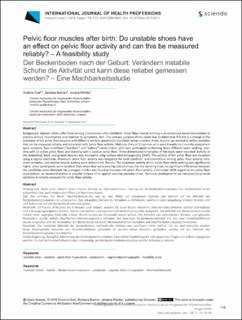Please use this identifier to cite or link to this item:
https://doi.org/10.21256/zhaw-18681Full metadata record
| DC Field | Value | Language |
|---|---|---|
| dc.contributor.author | Graf, Eveline | - |
| dc.contributor.author | Borner, Barbara | - |
| dc.contributor.author | Pehlke-Milde, Jessica | - |
| dc.date.accessioned | 2019-11-14T09:26:29Z | - |
| dc.date.available | 2019-11-14T09:26:29Z | - |
| dc.date.issued | 2019 | - |
| dc.identifier.issn | 2296-990X | de_CH |
| dc.identifier.uri | https://digitalcollection.zhaw.ch/handle/11475/18681 | - |
| dc.description.abstract | Background: Women often suffer from urinary incontinence after childbirth. Pelvic floor muscle training is an evidenced-based intervention to prevent urinary incontinence and improve its symptoms Aim: The primary purpose of this study was to determine if there is a change in the activation of the pelvic floor muscles with different extrinsic parameters (barefoot versus unstable shoe). Second, we wanted to define variables that can be measured reliably and correlated with pelvic floor activity. Methods: Data of 15 women who were 8 weeks to 6 months postpartum were analyzed. Two conditions (“barefoot” and “kyBoot”) were tested, with each participant performing three different tasks: walking, standing with an active pelvic floor, and standing with a passive pelvic floor. Three-dimensional kinematics of the body were recorded. Activity of the abdominal, back, and gluteal muscles was measured using surface electromyography (EMG). The activity of the pelvic floor was recorded using a vaginal electrode. Maximum pelvic floor activity was compared for each condition, and correlations among pelvic floor activity, kinematic variables, and skeletal muscle activity were determined. Results: The maximum activity of the pelvic floor while walking was significantly higher when participants were barefoot than when they were wearing kyBoot shoes. For the standing trials, no significant differences between the conditions were detected. No surrogate marker was found to measure the pelvic floor activity. Conclusion: With regard to the pelvic floor musculature, no recommendation is possible in favor of or against wearing unstable shoes. Technical developments are necessary to provide solutions to reliably measure the pelvic floor activity. | de_CH |
| dc.language.iso | en | de_CH |
| dc.publisher | De Gruyter | de_CH |
| dc.relation.ispartof | International Journal of Health Professions | de_CH |
| dc.rights | https://creativecommons.org/licenses/by-nc-nd/4.0/ | de_CH |
| dc.subject.ddc | 615.82: Physiotherapie | de_CH |
| dc.subject.ddc | 618: Geburtsmedizin und Hebammenarbeit | de_CH |
| dc.title | Pelvic floor muscles after birth : do unstable shoes have an effect on pelvic floor activity and can this be measured reliably? – a feasibility study | de_CH |
| dc.type | Beitrag in wissenschaftlicher Zeitschrift | de_CH |
| dcterms.type | Text | de_CH |
| zhaw.departement | Gesundheit | de_CH |
| zhaw.organisationalunit | Institut für Hebammenwissenschaft und reproduktive Gesundheit (IHG) | de_CH |
| zhaw.organisationalunit | Institut für Physiotherapie (IPT) | de_CH |
| dc.identifier.doi | 10.21256/zhaw-18681 | - |
| dc.identifier.doi | 10.2478/ijhp-2019-0013 | de_CH |
| zhaw.funding.eu | No | de_CH |
| zhaw.issue | 1 | de_CH |
| zhaw.originated.zhaw | Yes | de_CH |
| zhaw.pages.end | 123 | de_CH |
| zhaw.pages.start | 116 | de_CH |
| zhaw.publication.status | publishedVersion | de_CH |
| zhaw.volume | 6 | de_CH |
| zhaw.publication.review | Open peer review | de_CH |
| zhaw.funding.zhaw | Machbarkeitsstudie für die Entwicklung einer Einlegesohle für den kyBoot mit sensomotorischen Elementen zur Aktivierung des Beckenbodens nach der Geburt | de_CH |
| zhaw.author.additional | No | de_CH |
| Appears in collections: | Publikationen Gesundheit | |
Files in This Item:
| File | Description | Size | Format | |
|---|---|---|---|---|
| Graf_IJHP_2019.pdf | 651.99 kB | Adobe PDF |  View/Open |
Show simple item record
Graf, E., Borner, B., & Pehlke-Milde, J. (2019). Pelvic floor muscles after birth : do unstable shoes have an effect on pelvic floor activity and can this be measured reliably? – a feasibility study. International Journal of Health Professions, 6(1), 116–123. https://doi.org/10.21256/zhaw-18681
Graf, E., Borner, B. and Pehlke-Milde, J. (2019) ‘Pelvic floor muscles after birth : do unstable shoes have an effect on pelvic floor activity and can this be measured reliably? – a feasibility study’, International Journal of Health Professions, 6(1), pp. 116–123. Available at: https://doi.org/10.21256/zhaw-18681.
E. Graf, B. Borner, and J. Pehlke-Milde, “Pelvic floor muscles after birth : do unstable shoes have an effect on pelvic floor activity and can this be measured reliably? – a feasibility study,” International Journal of Health Professions, vol. 6, no. 1, pp. 116–123, 2019, doi: 10.21256/zhaw-18681.
GRAF, Eveline, Barbara BORNER und Jessica PEHLKE-MILDE, 2019. Pelvic floor muscles after birth : do unstable shoes have an effect on pelvic floor activity and can this be measured reliably? – a feasibility study. International Journal of Health Professions. 2019. Bd. 6, Nr. 1, S. 116–123. DOI 10.21256/zhaw-18681
Graf, Eveline, Barbara Borner, and Jessica Pehlke-Milde. 2019. “Pelvic Floor Muscles after Birth : Do Unstable Shoes Have an Effect on Pelvic Floor Activity and Can This Be Measured Reliably? – a Feasibility Study.” International Journal of Health Professions 6 (1): 116–23. https://doi.org/10.21256/zhaw-18681.
Graf, Eveline, et al. “Pelvic Floor Muscles after Birth : Do Unstable Shoes Have an Effect on Pelvic Floor Activity and Can This Be Measured Reliably? – a Feasibility Study.” International Journal of Health Professions, vol. 6, no. 1, 2019, pp. 116–23, https://doi.org/10.21256/zhaw-18681.
Items in DSpace are protected by copyright, with all rights reserved, unless otherwise indicated.